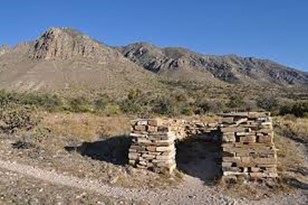
stop near Horsehead Crossing. (wikiwand.com)
My favorite attorney in early Greenville, Alfred Thomas Howell, wrote to his brother in March 1854. Alfred had recently met a couple of speculators taking herds of cattle from different points in the East Texas to California and were trying to procure “hands”, offering ten dollars per month and furnish everything, including a horse. If the hand owned his own horse, he received fifteen dollars a month. The speculators also bought cattle to take on the journey. Cattle brought a high price where gold mining was the most important proposition and food and sleeping were not as needed.
As the herds moved west, with the young herders now “cow-herders” learned a lot. The trail became dustier and drier along the way. The most difficult part of the trail was a 79-mile drive from what is now Odessa to the Pecos River. Reaching the Pecos, drovers and herders were amazed at the massive amounts of horse skulls.
Most historians believe the skulls were left there by the Comanche and Kiowa driving horses from the High Plains to the large haciendas in Mexico for trading. Old Rip Ford, noted Texas Ranger, told that the Comanches drove the horses so hard from the last water hole, sixty miles beyond the Pecos, that the thirsty horses sometimes drank themselves to death drinking the briny Pecos water. Hence, the name Horse Head Crossing.
This was the only crossing for miles. The Pecos was known for its steep, muddy banks, unpredictable currents, and quicksand, all-natural barriers to travel. At the major crossing of the Pecos, mesquite trees were topped with skulls to mark the site.
The Comanches and Kiowas was probably the first to use the route traversed as they moved stolen horses from raids in Mexico to the Llano Estacado for years. By 1839 Dr. Henry Connelly crossed on his way from Fort Dawson to Chihuahua. In April 1849 an expedition headed by John S. (Rip) Ford and Robert S. Neighbors reached the crossing in search of a wagon route to El Paso. John Russell Bartlett, United States boundary commissioner, led an expedition to Horsehead Crossing in 1850 in search of a practical route to California. Within a few years, stagecoach routes were traversing the ford. Henry Skillman drove the Butterfield Overland Mail stage through in the 1850s. A stage station was established about a quarter mile above the crossing.
Beginning in the 1860s cattlemen frequently drove their herds across Horsehead Crossing. Charles L. Pyron drove a herd of 10,000 cattle across in 1866. The same year John Chisum drove 600 steers to Bosque Grande by way of Horsehead Crossing. Also, in 1866 Charles Goodnight, Oliver Loving, and W. J. Wilson drove cattle up the Pecos River past Horsehead Crossing on the Goodnight-Loving Trail. After losing hundreds of cattle in the desert and river, Goodnight described the Pecos as the “graveyard of the cowman’s hopes.”
The end of the cattle drives and modern road construction decreased the importance of Horsehead Crossing by the twentieth century. In 1936 the Texas Centennial Commission placed a historical marker at the site.
